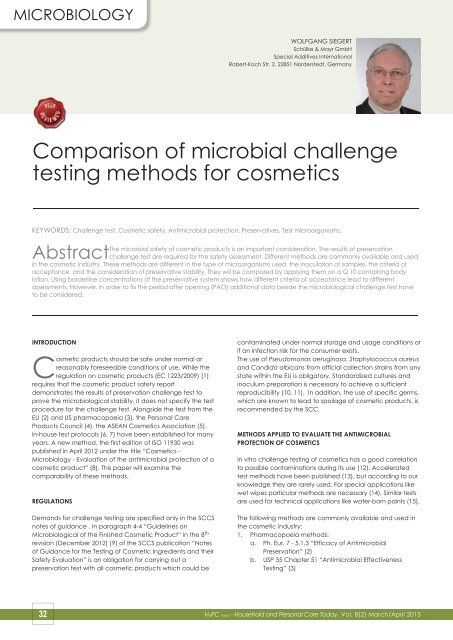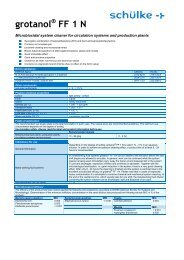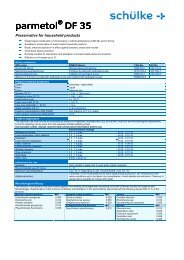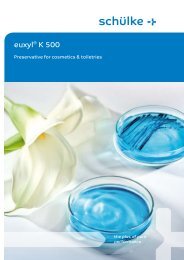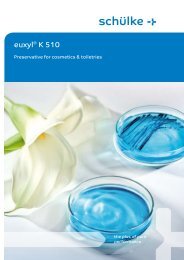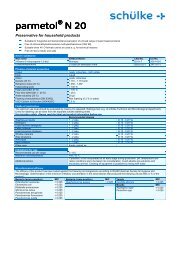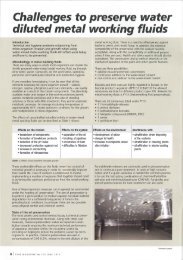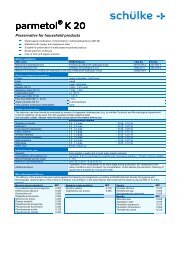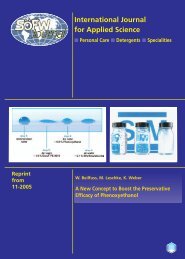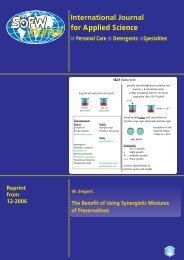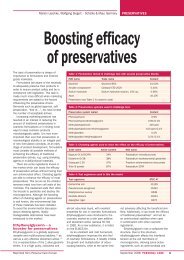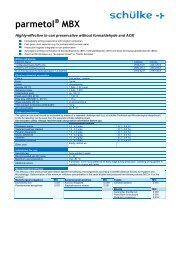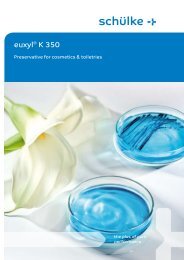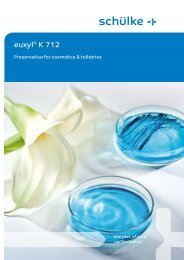Comparison of microbial challenge testing methods ... - ResearchGate
Comparison of microbial challenge testing methods ... - ResearchGate
Comparison of microbial challenge testing methods ... - ResearchGate
You also want an ePaper? Increase the reach of your titles
YUMPU automatically turns print PDFs into web optimized ePapers that Google loves.
MICROBIOLOGY<br />
WOLFGANG SIEGERT<br />
Schülke & Mayr GmbH<br />
Special Additives International<br />
Robert-Koch Str. 2, 22851 Norderstedt, Germany<br />
<strong>Comparison</strong> <strong>of</strong> <strong>microbial</strong> <strong>challenge</strong><br />
<strong>testing</strong> <strong>methods</strong> for cosmetics<br />
KEYWORDS: Challenge test, Cosmetic safety, Anti<strong>microbial</strong> protection, Preservatives, Test microorganisms.<br />
The <strong>microbial</strong> safety <strong>of</strong> cosmetic products is an important consideration. The results <strong>of</strong> preservation<br />
Abstract<strong>challenge</strong> test are required for the safety assessment. Different <strong>methods</strong> are commonly available and used<br />
in the cosmetic industry. These <strong>methods</strong> are different in the type <strong>of</strong> microorganisms used, the inoculation <strong>of</strong> samples, the criteria <strong>of</strong><br />
acceptance, and the consideration <strong>of</strong> preservative stability. They will be compared by applying them on a Q 10 containing body<br />
lotion. Using borderline concentrations <strong>of</strong> the preservative system shows how different criteria <strong>of</strong> acceptance lead to different<br />
assessments. However, in order to fix the period after opening (PAO) additional data beside the microbiological <strong>challenge</strong> test have<br />
to be considered.<br />
INTRODUCTION<br />
Cosmetic products should be safe under normal or<br />
reasonably foreseeable conditions <strong>of</strong> use. While the<br />
regulation on cosmetic products (EC 1223/2009) (1)<br />
requires that the cosmetic product safety report<br />
demonstrates the results <strong>of</strong> preservation <strong>challenge</strong> test to<br />
prove the microbiological stability, it does not specify the test<br />
procedure for the <strong>challenge</strong> test. Alongside the test from the<br />
EU (2) and US pharmacopoeia (3), the Personal Care<br />
Products Council (4), the ASEAN Cosmetics Association (5),<br />
in-house test protocols (6, 7) have been established for many<br />
years. A new method, the first edition <strong>of</strong> ISO 11930 was<br />
published in April 2012 under the title “Cosmetics -<br />
Microbiology - Evaluation <strong>of</strong> the anti<strong>microbial</strong> protection <strong>of</strong> a<br />
cosmetic product” (8). This paper will examine the<br />
comparability <strong>of</strong> these <strong>methods</strong>.<br />
REGULATIONS<br />
Demands for <strong>challenge</strong> <strong>testing</strong> are specified only in the SCCS<br />
notes <strong>of</strong> guidance . In paragraph 4-4 “Guidelines on<br />
Microbiological <strong>of</strong> the Finished Cosmetic Product“ in the 8 th<br />
revision (December 2012) (9) <strong>of</strong> the SCCS publication “Notes<br />
<strong>of</strong> Guidance for the Testing <strong>of</strong> Cosmetic Ingredients and their<br />
Safety Evaluation” is an obligation for carrying out a<br />
preservation test with all cosmetic products which could be<br />
contaminated under normal storage and usage conditions or<br />
if an infection risk for the consumer exists.<br />
The use <strong>of</strong> Pseudomonas aeruginosa, Staphylococcus aureus<br />
and Candida albicans from <strong>of</strong>ficial collection strains from any<br />
state within the EU is obligatory. Standardized cultures and<br />
inoculum preparation is necessary to achieve a sufficient<br />
reproducibility (10, 11). In addition, the use <strong>of</strong> specific germs,<br />
which are known to lead to spoilage <strong>of</strong> cosmetic products, is<br />
recommended by the SCC.<br />
METHODS APPLIED TO EVALUATE THE ANTIMICROBIAL<br />
PROTECTION OF COSMETICS<br />
In vitro <strong>challenge</strong> <strong>testing</strong> <strong>of</strong> cosmetics has a good correlation<br />
to possible contaminations during its use (12). Accelerated<br />
test <strong>methods</strong> have been published (13), but according to our<br />
knowledge they are rarely used. For special applications like<br />
wet wipes particular <strong>methods</strong> are necessary (14). Similar tests<br />
are used for technical applications like water-born paints (15).<br />
The following <strong>methods</strong> are commonly available and used in<br />
the cosmetic industry:<br />
1. Pharmacopoeia <strong>methods</strong>:<br />
a. Ph. Eur. 7 - 5.1.3 “Efficacy <strong>of</strong> Anti<strong>microbial</strong><br />
Preservation” (2)<br />
b. USP 35 Chapter 51 “Anti<strong>microbial</strong> Effectiveness<br />
Testing” (3)<br />
32<br />
H&PC Today - Household and Personal Care Today, Vol. 8(2) March/April 2013
2. CTFA Microbiology Guidelines:<br />
a. CTFA M-3 “A Method for Preservation Testing <strong>of</strong><br />
Water-Miscible Personal Care Products” (4)<br />
b. CTFA M-4 “Method for Preservation Testing <strong>of</strong> Eye<br />
Area Cosmetics” (4)<br />
c. CTFA M-5 Methods for Preservation Testing <strong>of</strong><br />
Nonwoven Substrate Personal Care Products (4)<br />
d. CTFA M-6 A Method for Preservation Testing <strong>of</strong><br />
Atypical Personal Care Products (4)<br />
e. CTFA M-7 A Rapid Method for Preservation Testing<br />
<strong>of</strong> Water-Miscible Personal Care Products (4)<br />
3. ASEAN Cosmetic Harmonized Testing Method<br />
Association <strong>of</strong> Southeast Asian Nations, Preservative<br />
efficacy test for cosmetic product, Document N° ACM<br />
MAL 08 (5):<br />
4. In-house test protocols:<br />
a. schülke KoKo test “Determination <strong>of</strong> the Preserving<br />
Effect <strong>of</strong> Chemical Preservatives in Cosmetic<br />
Formulations” (6, 7)<br />
b. schülke FeuTuKo test “Method to Determine the<br />
Preserving Effect <strong>of</strong> Chemical Preservatives in Wet<br />
Tissues” (16)<br />
5. ISO standard:<br />
a. IS0 11930 “Evaluation <strong>of</strong> the anti<strong>microbial</strong> protection<br />
<strong>of</strong> a cosmetic product” (8)<br />
For water soluble or water miscible products such as<br />
shampoos, lotions, creams etc. usually the pharmacopoeia<br />
<strong>methods</strong>, the- KoKo test, the CTFA M-3, CTFA M-4 or the<br />
ASEAN test are used to prove the anti<strong>microbial</strong> protection.<br />
As an ISO standard a new method was published in-April<br />
2012, the ISO 11930. These <strong>methods</strong> are compared in the<br />
following paragraphs.<br />
Compared to other <strong>methods</strong> ISO 11930 is an overall<br />
standard to evaluate the anti<strong>microbial</strong> stabilisation <strong>of</strong> a<br />
cosmetic product. With the decision diagram in<br />
Annex A also formulations intrinsically hostile to<br />
<strong>microbial</strong> growth, specific manufacturing<br />
conditions, packaging and/or conditions for use<br />
and the reference to ISO 29261 (Guidelines for the<br />
risk assessment and indemnification <strong>of</strong><br />
microbiologically low risk products) (17) are<br />
covered.<br />
A preservation efficacy test is according to ISO<br />
11930 not required for those cosmetic products for<br />
which the microbiological risk has been<br />
determined to be low in accordance with ISO<br />
29621. Some examples <strong>of</strong> low risk products are<br />
shown in table 1.<br />
area cosmetics and other water miscible cosmetic products.<br />
Eye cosmetics are recommended to be tested with more<br />
species. Nevertheless, the CTFA <strong>methods</strong> have the biggest<br />
variability, only the use <strong>of</strong> different types <strong>of</strong> microorganisms is<br />
specified. The CTFA includes in their selection lists typical<br />
product spoiling microorganisms; they can be tested instead<br />
or in addition to pathogenic species.<br />
The schülke KoKo test includes these microorganisms,<br />
selected using decades <strong>of</strong> experience from schülke’s<br />
support services to cosmetic producers through the scope <strong>of</strong><br />
MQM (Microbiological Quality Management). Only the<br />
schülke KoKo test completely fulfil recommendations <strong>of</strong> the<br />
SCCS Notes <strong>of</strong> Guidance.<br />
CULTIVATION OF TEST MICROORGANISMS<br />
The cultivation <strong>of</strong> the test germs is comparable for all<br />
<strong>methods</strong>. The surface <strong>of</strong> a suitable solid agar medium is<br />
inoculated separately with the specified microorganisms.<br />
Typical culture conditions are:<br />
--<br />
Bacteria 30-35°C / 18-24 h<br />
--<br />
Yeasts 20-25°C / 44-52 h<br />
--<br />
Moulds 20-25°C / 6-10 days<br />
Table 1. Product characteristics and their combinations<br />
may be considered as examples <strong>of</strong> low-risk products.<br />
TEST MICROORGANISMS<br />
The recommended microorganisms for the<br />
different test <strong>methods</strong> are summarised in table 2.<br />
The ISO 11930, the Ph. Eur. 7, the USP 35 and the<br />
ASEAN tests use only pathogenic microorganisms;<br />
they only partly fulfil the recommendation <strong>of</strong> the<br />
SCCS to use additional specific germs, which are<br />
known to lead to spoilage <strong>of</strong> cosmetic products.<br />
The Ph. Eur. 7 recommends an optional use <strong>of</strong><br />
“strains or species that may represent likely<br />
contaminants to the preparation”.<br />
The test <strong>methods</strong> from the CTFA Microbiology<br />
Guidelines differentiate between <strong>testing</strong> <strong>of</strong> eye<br />
Table 2. Microorganisms used for <strong>challenge</strong> <strong>testing</strong>.<br />
H&PC Today - Household and Personal Care Today, Vol. 8(2) March/April 2013<br />
33
PRODUCTION OF INOCULUM<br />
For the production <strong>of</strong> an inoculum, microorganisms are washed<br />
<strong>of</strong>f from the nutrient media plates and adjusted to the required<br />
starting germ count by dilution. The inoculum is then directly used<br />
to inoculate the test samples according to ISO 11930, Ph. Eur.<br />
7and ASEAN. The CTFA tests accept the use <strong>of</strong> either as well pure<br />
or mixed culture suspensions, the schülke KoKo test uses mixed<br />
culture suspensions (i.e. single cultivated microorganisms brought<br />
together into a mixed suspension). To guarantee a constant<br />
composition <strong>of</strong> the mixed inoculum the mixed suspension is<br />
stored for maximum <strong>of</strong> three days in a refrigerator. A new<br />
inoculation suspension is prepared for each inoculation cycle.<br />
All tests have similar bacteria loads in the inoculated sample.<br />
The mould load is slightly higher in the pharmaceutical tests.<br />
CRITERIA OF ACCEPTANCE<br />
The criteria <strong>of</strong> acceptance are summarised in table 3. In figure 2<br />
the differences are visualised as graphic representation.<br />
INOCULATION OF SAMPLES<br />
Each container is inoculated with a measured amount <strong>of</strong><br />
inoculum and thoroughly mixed to ensure homogeneous<br />
distribution <strong>of</strong> inoculum. The quantity <strong>of</strong> inoculum is typically 1 %<br />
<strong>of</strong> the test sample. The initial concentration <strong>of</strong> microorganisms<br />
present in the inoculated product with regard to the different test<br />
<strong>methods</strong> are demonstrated in the figure 1.<br />
Figure 2. Criteria <strong>of</strong> acceptance - graphical representation.<br />
Figure 1. Microorganism counts and the quantity <strong>of</strong><br />
inoculum used for <strong>challenge</strong> <strong>testing</strong>.<br />
For Ph. Eur.; KoKo and ISO 11930 <strong>challenge</strong> <strong>testing</strong> A and B<br />
criteria are defined. The differentiation for Ph. Eur. test is<br />
related to the risk. Criteria B is acceptable if a preservation<br />
fulfilling criteria A, for example leads to an increased risk <strong>of</strong><br />
adverse reactions. For ISO 11930 and KoKo test the<br />
microbiological risk analysis is the possible differentiation. The<br />
existence <strong>of</strong> control factors not related to the formulation; for<br />
example, a protective package such as a pump providing a<br />
higher level <strong>of</strong> protection than a jar and/or following strong<br />
demands on good manufacturing practice has to be<br />
demonstrated to accept criteria B.<br />
PRESERVATIVE STABILITY<br />
Preservative stability is an important factor to ensure the<br />
<strong>microbial</strong> quality. The SCCS requires (9):<br />
Table 3. Criteria <strong>of</strong> acceptance.<br />
Table 4. Instructions related to preservative stability in the<br />
different <strong>challenge</strong> test <strong>methods</strong>.<br />
34 H&PC Today - Household and Personal Care Today, Vol. 8(2) March/April 2013
--<br />
The efficacy <strong>of</strong> the preservation <strong>of</strong> a cosmetic product<br />
under development has to be assessed experimentally in<br />
order to ensure <strong>microbial</strong> stability and preservation during<br />
storage and use.<br />
To ensure a safe preservation over the shelf life <strong>of</strong> a cosmetic<br />
product a single inoculation <strong>of</strong> a fresh prepared sample is<br />
insufficient. Degradation or inactivation <strong>of</strong> actives may occur,<br />
e.g. methylchloroisothiazolinone or bronopol at alkaline pH.<br />
Table 4 shows the instructions related to preservative stability <strong>of</strong><br />
the different test <strong>methods</strong>.<br />
Figure 3. Life cycle <strong>of</strong> a cosmetic product.<br />
ASSESSMENT OF THE PERIOD AFTER OPENING<br />
In the Cosmetic Regulation (EC) No 1223/2009 (1) article 19c is<br />
required:<br />
--<br />
Indication <strong>of</strong> the date <strong>of</strong> minimum durability shall not be<br />
mandatory for cosmetic products with a minimum durability<br />
<strong>of</strong> more than 30 months. For such products, there shall be<br />
an indication <strong>of</strong> the period <strong>of</strong> time after opening for which<br />
the product is safe and can be used without any harm to<br />
the consumer.<br />
This requirement was already described under article 6(1)(c) <strong>of</strong><br />
the Cosmetics Directive (76/768/EEC) (18). This period after<br />
opening (PAO) cannot be fixed only on the basis <strong>of</strong> a <strong>challenge</strong><br />
test. The life cycle <strong>of</strong> a product is shown in figure 3.<br />
The <strong>challenge</strong> test, especially the KoKo test, can guaranty the<br />
safe production and filling including the storage in the closed<br />
Table 5. Selected preservative systems used in the<br />
<strong>challenge</strong> tests.<br />
package. The fixing <strong>of</strong> the PAO has to include additional data<br />
beside the microbiological<br />
<strong>challenge</strong> test for example (19):<br />
--<br />
Analytical data (e.g.<br />
analyses <strong>of</strong> preservatives,<br />
preferably according to the<br />
<strong>methods</strong> <strong>of</strong> analysis<br />
published by the European<br />
Commission (20))<br />
--<br />
Type <strong>of</strong> packaging<br />
--<br />
Experience with similar<br />
recipes and product<br />
--<br />
Complaint statistics<br />
--<br />
Consumer habits and<br />
practices<br />
Modern s<strong>of</strong>t preservatives, e.g.<br />
the combination phenoxyethanol<br />
/ ethylhexylglycerin are not<br />
suspect to degradation. A good<br />
stability can be expected, the<br />
possible migration in the oil phase<br />
is according to our experience<br />
completed during the six weeks<br />
<strong>testing</strong> time <strong>of</strong> the KoKo. For the<br />
acid based preservatives at a<br />
minimum the pH stability <strong>of</strong> the<br />
cosmetic formulation has to be<br />
checked over a longer storage<br />
period.<br />
For the highly reactive<br />
preservatives such as<br />
isothiazolinones, bronopol,<br />
formaldehyde donors etc.<br />
analytical date for the long term<br />
stability in the cosmetic product Figure 4. <strong>Comparison</strong> <strong>of</strong> the test results Ph. Eur. and ISO 11930.<br />
may be necessary.<br />
H&PC Today - Household and Personal Care Today, Vol. 8(2) March/April 2013<br />
37
EXPERIMENTAL DATA<br />
Using an unpreserved body lotion containing Q10<br />
(INCI: aqua, glycerin, ethylhexyl stearate, isopropyl<br />
palmitate, cetearyl isononanoate, glyceryl stearate<br />
citrate, cetearyl alcohol, persea gratissima oil,<br />
tocopheryl acetate, creatine, parfum, carbomer,<br />
allantoin, sodium hydroxide, xanthan gum,<br />
ubiquinone), we ran the preservative efficacy tests<br />
according to ISO 11930 in comparison to Ph. Eur. 7<br />
and the schülke KoKo test. Formulations containing<br />
coenzyme Q-10 (ubiquinone) are known to be more Table 6. Results <strong>of</strong> the KoKo tests.<br />
susceptible to mould growth (21). Table 5 shows the<br />
preservative systems which have been added for<br />
<strong>challenge</strong> <strong>testing</strong>.<br />
For the ISO 11930 and Ph. Eur. test reduction in <strong>microbial</strong> counts<br />
are expressed in log units (R x =lgN 0 - lgN x ). Negative figures<br />
indicate an increase <strong>of</strong> the <strong>microbial</strong> count in the test sample.<br />
The results are summarised in figure 4.<br />
Table 7. Summary experimental datas.<br />
For the KoKo test, the preserving effect is evaluated semiquantitatively<br />
by the growth <strong>of</strong> different streaks. The results are<br />
summarised in table 6.<br />
SUMMARY EXPERIMENTAL DATA<br />
The criteria <strong>of</strong> acceptance for ISO 11930 appear to be the<br />
easiest to fulfil. It is questionable if the demands <strong>of</strong> protection for<br />
a cosmetic product should not be stricter than for<br />
pharmaceutical products. The test for efficacy <strong>of</strong> anti<strong>microbial</strong><br />
preservation according to EU Pharmacopoeia and the criteria <strong>of</strong><br />
acceptance are designed for the production <strong>of</strong> drugs under the<br />
strong requirements <strong>of</strong> the pharmaceutical GMP (Good<br />
Manufacturing Practice). Additionally the useable lifespan after<br />
opening <strong>of</strong> cosmetic products are generally longer than for<br />
pharmaceutical products.<br />
The schülke KoKo test is specifically verified for the assessment <strong>of</strong><br />
cosmetic products. From more than 25 years <strong>of</strong> experience (6,7)<br />
with this test method, we can state a 30 month microbiological<br />
stability for a product passing criteria A, which is recommended<br />
for cosmetic products.<br />
For all <strong>methods</strong> the period after opening has to be assessed<br />
separately.<br />
The lotion with the preservative system 1 passed only ISO 11930<br />
and Ph. Eur. criteria B. Nevertheless, even 28 days after the<br />
inoculation with Aspergillus brasiliensis it was still detectable.<br />
Within 7 days the decrease <strong>of</strong> moulds is insufficient, the KoKo<br />
failed.<br />
The lotion with the preservative system 2 and 3 passed ISO 11930<br />
and Ph. Eur.; KoKo showed only slight growth in the last cycles, it<br />
fulfils criteria B.<br />
PRECISION AND REPRODUCIBILITY OF PRESERVATIVE<br />
EFFICACY TESTS<br />
To asses the differences in the results <strong>of</strong> the different test<br />
<strong>methods</strong>, it is important to realise the variation in microbiological<br />
test results. The GÖCH has published the results <strong>of</strong> a round robin<br />
test for Ph. Eur. - 5.1.3 “Efficacy <strong>of</strong> Anti<strong>microbial</strong> Preservation” (22).<br />
The <strong>microbial</strong> counts differed widely between the laboratories.<br />
Figure 2 shows an overview <strong>of</strong> the results including expanded<br />
uncertainty.<br />
Figure 5. GÖCH results <strong>of</strong> round robin test including<br />
expanded uncertainty.<br />
For the other <strong>methods</strong> this data is not available, probably<br />
however it can be assumed that it is in the same range.<br />
Borderline results with low reduction in <strong>microbial</strong> counts might fail<br />
in a replicate. Uncertain contaminations during production<br />
combined with an insufficient speed <strong>of</strong> killing may lead to<br />
detection <strong>of</strong> contamination in the market place. The worst case<br />
is the inclusion in the RAPEX notifications (23).<br />
CONCLUSIONS<br />
The ISO 11930 as new standard to evaluate the anti<strong>microbial</strong><br />
protection <strong>of</strong> a cosmetic product includes a reference method<br />
to evaluate the preservation, as well as a decision diagram to<br />
evaluate the microbiological risk. The recommended<br />
preservation efficacy test is less strict than the Ph. Eur. and the<br />
KoKo test (see 9. Experimental data). The <strong>microbial</strong> strains did not<br />
include typical product spoiling microorganisms along side the<br />
pathogenic germs as required by the SCCS (9). The stability <strong>of</strong> a<br />
preservative is not taken into account by ISO 11930.<br />
Formulations passing KoKo or Ph. Eur. criteria A can be also<br />
evaluated as safe according to ISO 11930 criteria A.<br />
It is likely that products tested according to CTFA M-3 or M-4 will<br />
be safe as the requirement for a germ count reduction within<br />
seven days is more rigorous than that <strong>of</strong> ISO 11930 and<br />
comparable to the KoKo test.<br />
The ASEAN test is comparable to ISO 11930.<br />
The USP 35 can be considered as a weak standard; the demands<br />
38 H&PC Today - Household and Personal Care Today, Vol. 8(2) March/April 2013
are below those for ISO 11930. It is advisable to perform a test<br />
according to one <strong>of</strong> the <strong>methods</strong> designed for cosmetics.<br />
REFERENCES AND NOTES<br />
1. Regulation (EC) No 1223/2009 <strong>of</strong> the European parliament and the<br />
council <strong>of</strong> Europe <strong>of</strong> 30 November 2009 on cosmetic products<br />
http://eur-lex.europa.eu/LexUriServ/LexUriServ.do?uri=OJ:L:2009:342:<br />
0059:0209:EN:PDF<br />
2. European Pharmacopeia 7th edition, Chapter 5.1.3. Efficacy <strong>of</strong><br />
anti<strong>microbial</strong> preservation<br />
3. United States Pharmacopoeia (USP 35); Chapter 51 Anti<strong>microbial</strong><br />
effectiveness <strong>testing</strong><br />
4. Personal Care Products Council (PCPC - formerly the Cosmetic,<br />
Toiletry and Fragrance Association); CTFA Microbiology Guidelines<br />
2007<br />
5. Association <strong>of</strong> Southeast Asian Nations, Preservative efficacy test for<br />
cosmetic product, Document N° ACM MAL 08<br />
6. Siegert, Evaluation <strong>of</strong> the Microbiological Safety <strong>of</strong> Finished Cosmetic<br />
Products, Euro Cosmetics 3-2010<br />
7. H. Brill, Prüfverfahren zur Bestimmung der mikrobiologischen<br />
Wirksamkeit con chemischen Konservierungsmitteln für Kosmetika,<br />
Jahrbuch für den Praktiker 1987<br />
8. ISO 11930, Cosmetics - Microbiology - Evaluation <strong>of</strong> the anti<strong>microbial</strong><br />
protection <strong>of</strong> a cosmetic product<br />
9. Scientific Committee on Consumer Safety (SCCS), The SCCS’s Notes<br />
<strong>of</strong> Guidance for the Testing <strong>of</strong> Cosmetic Ingredients and their Safety<br />
Evaluation, 8 th Revision<br />
10. Al-Hiti, P. Gilbert, Note on inoculum reproducibility comparison<br />
between solid and liquid culture, Journal <strong>of</strong> Applied Microbiology<br />
1983<br />
11. P. Gilbert, M. R. W. Brown, J. W. Inocula for anti<strong>microbial</strong> sensitivity<br />
<strong>testing</strong>: a critical review Journal <strong>of</strong> Applied Anti<strong>microbial</strong><br />
Chemotherapy 1987<br />
12. Daniel K. Brannan, James C. Dille, David J. Kaufman, Correlation <strong>of</strong><br />
In Vitro Challenge Testing with Consumer Use Testing for Cosmetic<br />
Products, Applied and Environmental Microbiology Aug.1987<br />
13. John I. Yablonski, Sharon E. Mancuso, Preservative Efficacy Testing:<br />
Accelerating the Process, Cosmetics & Toiletries magazine, Vol. 122,<br />
No. 10/0ctober 2007<br />
A. Cremieux, Method evaluation <strong>of</strong> the efficacy anti<strong>microbial</strong><br />
preservatives cosmetic wet wipes, International Journal <strong>of</strong> Cosmetic<br />
Science, 2005<br />
14. Karen Winkowski, Efficacy <strong>of</strong> in can preservatives, ECJ 2001<br />
15. W. Siegert, Microbiological quality management for the production<br />
<strong>of</strong> wet-wipes, Household and Personal Care Today 2/2008<br />
16. ISO 29621, Cosmetics - Microbiology - Guidelines for the risk<br />
assessment and identification <strong>of</strong> microbiologically low-risk products<br />
17. COUNCIL DIRECTIVE <strong>of</strong> 27 July 1976 on the approximation <strong>of</strong> the laws<br />
<strong>of</strong> the Member States relating to cosmetic products (76/768/EEC)<br />
http://eur-lex.europa.eu/LexUriServ/LexUriServ.do?uri=CONSLEG:1976<br />
L0768:20120823:EN:PDF (consolidated version)<br />
18. Practical implementation <strong>of</strong> Article 6(1)(c) <strong>of</strong> the Cosmetics Directive<br />
(76/768/EEC)1:LABELLING OF PRODUCT DURABILITY: “PERIOD OF TIME<br />
AFTER OPENING” http://ec.europa.eu/consumers/sectors/<br />
cosmetics/files/doc/wd-04-entr-cos_28_rev_version_<br />
adoptee20040419_en.pdf<br />
19. European Commission, Enterprise Directorate-General,<br />
Pharmaceuticals and cosmetics, Volume 2 - Cosmetics legislation -<br />
Cosmetic products - Methods <strong>of</strong> analysis – 1999, http://ec.europa.<br />
eu/consumers/sectors/cosmetics/files/pdf/vol_2en_en.pdf<br />
20. W. Siegert, Experiences from 30 years <strong>challenge</strong> <strong>testing</strong> as customer<br />
service in the schülke laboratories, unpublished<br />
21. GÖCH Arbeitskreis “Mikrobiologie”, Zwischenbericht Ringversuch<br />
Konservierungsbelastungstest (KBT) kosmetische Mittel http://www.<br />
goech.at/files/2011_GOECH_Arbeitskreis_1_<br />
Veroeffentlichung_110118.pdf<br />
22. European Commission, RAPEX - Latest notifications, http://ec.<br />
europa.eu/consumers/dyna/rapex/rapex_archives_en.cfm


